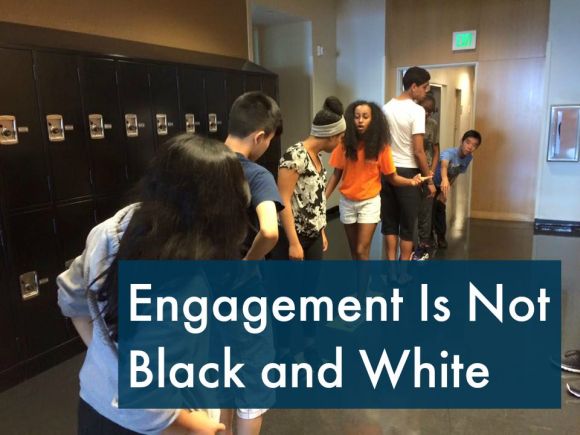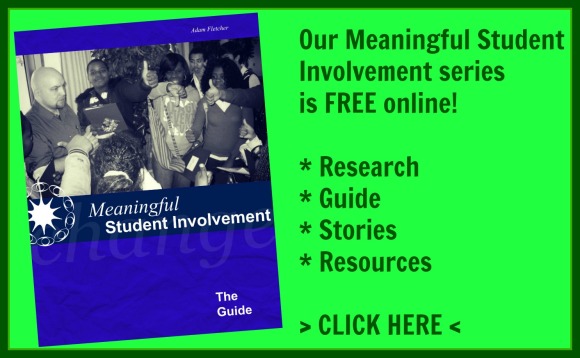
Student engagement is increasingly seen as an indicator of successful classroom instruction(1), and is increasingly valued as an outcome of school improvement activities. Students are engaged when they are attracted to their work, persist in despite challenges and obstacles, and take visible delight in accomplishing their work.(2)

Definitions and Differences
Student engagement also refers to a “student’s willingness, need, desire and compulsion to participate in, and be successful in, the learning process.”(3) Definitions In a number of studies student engagement has been identified as a desirable trait in schools; however, there is little consensus among students and educators as to how to define it.(4) They frequently include a psychological and behavioral component. Student engagement is used to discuss students’ attitudes towards school, while student disengagement identifies withdrawing from school in any significant way.(5)
SoundOut defines student engagement as “any sustained connection a learner has towards any aspect of learning, schools or education.”
A number of studies have shown that student engagement overlaps with, but is not the same as, student motivation.(6) The term “student engagement” has been used to depict students’ willingness to participate in routine school activities, such as attending classes, submitting required work, and following teachers’ directions in class.(7)
That includes participating in the activities offered as part of the school program8 and student participation in school reform activities.(9)
“[Students] who are engaged show sustained behavioral involvement in learning activities accompanied by a positive emotional tone. They select tasks at the border of their competencies, initiate action when given the opportunity, and exert intense effort and concentration in the implementation of learning tasks; they show generally positive emotions during ongoing action, including enthusiasm, optimism, curiosity, and interest.”(10)
Another study identified five indicators for student engagement in college. They include:
- the level of academic challenge
- active and collaborative learning
- student-faculty interaction
- enriching education experiences and
- a supportive learning environment.(11)
Indicators of the absence of student engagement include unexcused absences from classes, cheating on tests, and damaging school property.(12)
“The opposite of engagement is disaffection. Disaffected [students] are passive, do not try hard, and give up easily in the face of challenges… [they can] be bored, depressed, anxious, or even angry about their presence in the classroom; they can be withdrawn from learning opportunities or even rebellious towards teachers and classmates.”(13)
Requirements
In listing their definitions of student engagement, many studies list requirements that must exist for student engagement to occur. These studies consistently imply that educators actively create the conditions that foster student engagement. The first step to whole-school improvement in the area of student engagement is for the entire building faculty to share a definition of student engagement.(14)
Other steps include teachers clearly articulating learning criteria and providing students with clear, immediate, and constructive feedback; clear and systematic demonstrations to students of the skills they need to be successful, and; demonstration of engagement in learning as a valuable aspect of their personalities.(15)
Relationships between students and adults in schools, and among students themselves, are a critical factor of student engagement. This is especially true among students considered to be at-risk and without other positive adult interaction.(16)
There are several strategies for developing these relationships, including acknowledging student voice, increasing intergenerational equity between students and adults in schools, and sustaining student/adult partnerships throughout the learning environment.(17)
A variety of teaching approaches, including didactic, experiential and other forms, can foster student engagement.(18) Some instruments, including the popular National Survey of Student Engagement, identify dozens of everyday indicators of student engagement, including hand-raising, technology usage and verbal interactions with peers.(19)
Assessing Student Engagement
Assessing student engagement is seen as an essential step towards a school becoming a successful proponent.(20) A teacher’s ability to engage students has been proposed as an element of teacher certification, and an essential component of teacher preparation curricula.(21, 22)
There are concerns that definitions and assessments of student engagement are often exclusive to the values represented by dominant groups within the learning environment where the analysis is conducted.(23)
There have been studies where students from minority groups within the learning environment and larger community have been central to the assessment of student engagement. Researchers in these activities have identified several elements of their activities that overlap with previous findings around student voice and student/adult partnerships.(24, 25)
There are several methods to measure student engagement. They include self-reporting, such as surveys, questionnaires, checklists and rating scales. Researchers also use direct observations, work sample analyses, and focused case studies.(26) There is an increasing amount of interest and commitment among researchers and educators to use students as assessment designers, evaluators and assessors. Studies that have used this “students as evaluators” model consistently report high levels of efficacy and depth in their findings, and researchers consistently attribute these outcomes to the participation of student evaluators.(27)
Summary
Critics have long been concerned about the lack of student engagement in schools, let alone school improvement. In the 1930s John Dewey proposed the radical transformation of schools that led to the creation of career and technical education courses over the next ninety years, all in the name of student engagement.(28)
In the early 1990s Jonathan Kozol observed that,
“[W]e have not been listening much to children in these recent years of summit conferences on education, of severe reports, and ominous prescriptions. The voices of children, frankly, have been missing from the whole discussion.”(29)
With these longstanding and powerful indictments, it is tantamount that all schools continue to evolve towards becoming more engaging, more meaningful and more powerful learning environments for all students.
Related Content
References
- Kenny, G. Kenny, D. and Dumont, R. (1995) Mission and Place: Strengthening Learning and Community Through Campus Design. Oryx/Greenwood. p. 37
- Schlecty, P. (1994). “Increasing Student Engagement.” Missouri Leadership Academy. p. 5.
- Bomia, L., Beluzo, L., Demeester, D., Elander, K., Johnson, M., & Sheldon, B. (1997). “The impact of teaching strategies on intrinsic motivation.” Champaign, IL: ERIC Clearinghouse on Elementary and Early Childhood Education. p. 294.
- Farmer-Dougan, Farmer-Dougan and McKinney, K. (nd) ìExamining Student Engagement at Illinois State University: An Exploratory Investigation.î Center for Teaching and Learning with Technology. Retrieved 7/2/07 from http://www.teachtech.ilstu.edu/resources/teachTopics/examEngage.php.
- Willms, J.D. (2003) Student Engagement at School: a sense of belonging and participation: Results from PISA 2000. Organisation for Economic Co-operation and Development. p. i.
- Sharan, S. Shachar, H. and Levine, T. (1999) ‘The Innovative School: organization and instruction. Praeger/Greenwood. p. 85.
- 7 Chapman, E. (2003). ìAlternative approaches to assessing student engagement rates,î Practical Assessment, Research & Evaluation, 8(13). Retrieved 7/2/07 from http://PAREonline.net/getvn.asp?v=8&n=13.
- Natriello, G. (1984). ìProblems in the evaluation of students and student disengagement from secondary schools,î Journal of Research and Development in Education, 17. p. 14.
- Fletcher, A. (2005) Meaningful student involvement: Guide to students as partners in school change. Olympia, WA: CommonAction. p. 4. Retrieved 7/2/07 from http://www.soundout.org/MSIGuide.pdf
- Skinner, E.A., & Belmont, M.J. (1993). ìMotivation in the classroom: Reciprocal effects of teacher behavior and student engagement across the school year,î Journal of Educational Psychology, 85(4). p. 572.
- Kenny, G. Kenny, D. and Dumont, R. (1995) p. 37
- Chapman, E. (2003).
- Skinner, E.A., & Belmont, M.J. (1993).
- Berardi, L. and Gerschick, T. (nd) ìUniversity Faculty Members’ Perceptions of Student Engagement: An Interview Study.î Center for Teaching, Learning and Technology. Retrieved 7/2/07 from http://www.teachtech.ilstu.edu/additional/tips/facEngage.php.
- Strong, R. Silver, H. and Robinson, A. (1995) ìWhat do students want (and what really motivates them)?î Educational Leadership. September. p. 25.
- McCombs, B.L., & Pope, J.E. (1994). Motivating hard to reach students. Washington, DC: American Psychological Association.
- Fletcher, A. (2005) Stories of meaningful student involvement. Olympia, WA: CommonAction. p. 19. Retrieved 7/2/07 from http://www.soundout.org/MSIStories.pdf
- Schunk, D. and Meece, J. (1992) Student Perceptions in the Classroom. Lawrence Erlbaum Associates. p. 27.
- (nd) Definitions from the National Survey of Student Engagement. Longwood University. Retrieved 7/2/07 from http://www.longwood.edu/assessment/Survey/Freshman/NSSE_Definitions.htm.
- (2005) ìUTC working to enhance student engagement.î University of Tennessee – Chattanooga. Retrieved 7/2/07 from http://www.utc.edu/news/qep.php.
- Cook-Sather, A. (2002). Re(in)forming the conversations: Student position, power, and voice in teacher education. Radical Teacher 64(2002), 21-28.
- Cook-Sather, A. (2001). Negotiating Worlds and Words: Writing About Studentsí Experiences of School. In Shultz, J. & Cook-Sather, A. (eds.). In our own words: Studentsí perspectives on school. Lanham, MD: Rowman & Littlefield.
- Hurtado, S. (1999) ìReaffirming Educators Judgment: Educational Value of Diversity.î Liberal Education. Spring, p. 28.
- Cervone, B. & Cushman, K. (2002). “Moving youth participation into the classroom: Students as allies.” New Directions for Youth Development 2002 (96) 83-100.
- Rubin, B. & Silva, E. (Eds.) (2003). Critical voices in school reform: Students living through change. New York & London: RoutledgeFalmer.
- Chapman, E. (2003).
- Fletcher, A. (2005). Meaningful Student Involvement Research Guide. Olympia, WA: CommonAction. Retrieved 7/2/07 from http://www.soundout.org/MSIResearch.pdf
- Dewey, J. (1938). Experience and Education. New York: Collier Books. (Collier edition first published 1963).
- Kozol, J. (1991). Savage Inequities. New York: Crown Publishers. p. 5.
